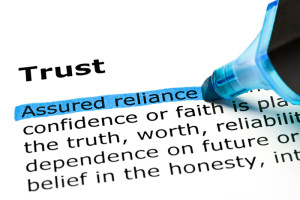
As society becomes increasingly digitized, we are seeing more and more disruptive business models attempt to leverage this trend and digitize traditional offerings. Examples include DIY investment solutions such as Nutmeg and online estate agencies such as Purple Bricks.
In doing so, these emergent disruptive brands face several challenges. These challenges go beyond the remits of operational and financial hurdles. In digitizing a sector, disruptive brands face an uphill battle to garner consumer trust – an essential component in their offering being accepted and considered for use.
But how can this intangible currency being generated?
Messaging Priorities
The immediate go-to messaging for brands looking to disrupt an industry by digitizing an offering is to strongly communicate their discounted prices – often one of their key competitive assets. Too often, what such brands forget is that lower prices vs. offline is now considered a hygiene factor for consumers shopping on digital platforms. In fact it often has the reverse effect when trying to garner trust as it presents a transactional based approach, insinuating capital gain, not service and satisfaction, is the priority. A communication of areas that are likely to encourage digital engagement – service and advice for example – are likely to persuade consumers you are there to help for the long term, not a quick, singular transaction. In the process, not only is trust gained, but the foundation for longer and more meaningful consumer relationships are also laid. This is evidenced by the approach of leading car sharing platform www.gocarshare.com where the emphasis on meeting new people and convenience overrides the exposure given to monetary savings.
Remember Offline
Overly disruptive change will often concern consumers in a society where digital anxiety is on the rise. As such, trying to remold an offering in a completely digital way may pose too much of a hurdle for consumers to consider uptake. It is important therefore to offer consumers an offline safety net – whether it be telephone contact or a postal address – to help them make the transition towards digital alternatives. By doing so, disruptive brands are communicating to consumers that they offer a trusted method of service support, will be present to quell any anxiousness and are there in partnership to help consumers cope with a transition to a digital approach to consumption. Much like how offering the traditional fallback of a telephone call on top of a digital process has, in part, allowed Uber to disrupt the taxi sector.
Be Personable
The cynical and digitally anxious 21st century consumer has an image of digitally focused businesses as being rigid, process based and algorithm orientated. This presents an obstacle as this stereotype does nothing to present an image of a brand being humanized nor does it generate warmth towards a digitally focused offering – key facets of trust. However, the inclusion of a brand ambassador, one who is known for their personable and friendly nature, can change this dynamic dramatically, by balancing digital stereotypes with real-life, well known personalities. Case in point here is the way that the personality of Martin Lewis is leveraged to give credit to the advice given on www.moneysavingexpert.com – a business that depends on visitors trusting its content in order for it to succeed. With its value going from £80 in £2003 to £35m when it was sold in 2012, the value of ambassador induced trust here is clear.
Win Over The Consumer, With The Consumer
Digitization and the openness of information it has generated has resulted in a more evolved and intelligent consumer. As such, consumers will not always absorb marketing messages that suggest they should trust new digital offerings as they can simply see communication tactics in action. In order to navigate round this, the usage of explicit consumer endorsement is more important than ever before for disruptive brands. AirBnB’s feedback loop is the classic example of this model and represents the core means by which consumers will decide whether or not to partake in a digital based transaction. Furthermore, the higher NET worth the service on sale, the greater depth of feedback is often required – as evidenced by the central location consumer reviews are given on the majority of online estate agency websites.
Transparency Orientated Trust
At the heart of all of these trust generating dynamics is the need for disruptive brands to operate in a transparent manner. Transparency around offering, pricing and openness around any service errors will show consumers that a brand operates in a trustworthy manner, by virtue of being open and honest. Such platforms for increasing transparency include an open digital social responsibility mandate when asking for consumer data and openly conversing on customer service issues on open social media platforms. Facebook – a disruptor to the advertising sector – have recently come under criticism in Germany for their failure to make clear to their users how their data is shared with advertisers, reflecting the consequences of a transparency shortfall.
With Edelman reporting that 2/3 of consumers do not trust brands they don’t use, it is vital for disruptive brands, with initially no usage, to build trust in ways such as this to maximize their chances of successful disruption and brand growth. In summary, this is best done by mechanisms used to look beyond transactions, the appropriate use of both human and offline elements, done in a transparent way.





